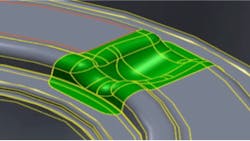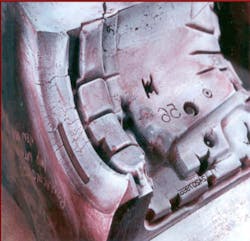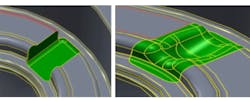Some metalcasters are developing a new application for additive manufacturing technologies in their operations, and a research consortium that includes aluminum diecasters as well as the North American Die Casting Assn. is working to make it commercially viable. The work is centered at Case Western Reserve University, where a professor of materials science and engineering, David Schwam, is leading the program to develop 3D printing methods to extend the life of machine dies.
Diecasting dies are the particular focus of this effort, though in an interview Schwam noted that the research has implications for forging and extrusion dies, too. That’s because a primary objective is to understand how to recognize and manage thermal stresses when manufacturing or repairing the dies. From that, specific industrial applications would follow.
Professor Schwam emphasized that the project does not aim to produce an entire die, but to work with the rough die forms and use tool steel grades in 3D printing processes to restore the surface details that are worn or damaged during production. Thus, one of the current limitations of additive manufacturing – the dimensions of the ‘build box’ — is less significant to the commercial potential of the concept.
The project sponsors estimate that this approach could save diecasters as much as $500 million in annual repair costs. A similar amount might be saved by domestic forging operations.
The research team will integrate 3D printing, cladding, cold plasma spraying, and various welding technologies to optimize methods and materials for different types of tools. Diecasters and other manufacturers will design fixtures and methods for fitting sections of large parts within 3D printers.
Once the damaged tools are restored, their performance will be compared with new tools, and all the findings will be formalized into “specifications for rejuvenating and repurposing specific materials and components, and submitted for consideration to national and international standardization bodies such as the American Society for Testing and Materials,” according to a release.
This research project is one of seven to earn funding from the National Additive Manufacturing Innovation Institute. NAMII was established in August 2012 under the U.S. National Network for Manufacturing Innovation (NNMI), a joint initiative of the U.S. Depts. of Energy, Defense, and Commerce, along with NASA and the National Science Foundation, to coordinate industrial and academic resources and capabilities for advanced manufacturing goals.
Accelerating development
Prof. Schwam explained that the project “essentially has started already,” though the kick-off will take place at a meeting April 2-3. He described it as an accelerated schedule for a program that has earned wide support and gained funding quickly, and he predicted their work would make rapid progress over the 22-month schedule.
NAMII is a federally sponsored program to promote additive manufacturing R&D, chartered “to accelerate additive manufacturing technologies to the U.S. manufacturing sector and increase domestic manufacturing competitiveness” by fostering collaboration; sponsoring development, evaluation, and deployment of additive manufacturing technologies; and educating students and training workers.
"Of the seven projects to be funded in the first set, CWRU will be the lead on two," according to James McGuffin-Cawley, chairman of the Materials Science and Engineering department there. "All these projects are characterized by strong partnerships including industrial companies, government labs, and academic partners,” he continued.
Along with the CWRU researchers, the program will have contributions from NADCA, Twin City Die Casting, General Die Casters, and Nebraska Aluminum Casting. Delaware Dynamics and DCD Technology, both of which produce diecasting molds also are involved, and MAGMA Foundry Technologies Inc. The latter company’s simulation technologies will be used to determine the appearance and location of thermal stress in die forms – similar to applications in core and mold design.
Prof. Schwam noted that welding processes provide a good foundation for the research, because the concept of attaching new material to a die surface parallels the joining process, and the principles of phase transformation that occur in welding are instructive to additive manufacturing too.
Sciaky Inc., a developer of advanced welding systems, is also part of the consortium, as are Lincoln Electric Co., the U.S. Army Research Laboratory and the Department of Army Research's Benet Laboratories, and Deformation Control Technology Inc., an engineering firm that specializes in simulation of metalworking and heat treat processes, finite-element analysis, and computer-based analysis.
A separate additive-manufacturing research program also earned NAMII support, and it involves research at CWRU as well asCarnegie Mellon University. That project aims to understand and control melt pool geometry, material microstructure, and mechanical properties of parts produced by two other additive manufacturing processes, the EOS Laser Sintering and Arcam Electron Beam Melting (EBM) methods. Both are powder bed-additive manufacturing processes that build metal components directly from metal powders. Among the research team members are Pratt & Whitney, GE Aviation, Lockheed Martin, Kennametal, the National Institute of Standards and Technology, and Oak Ridge National Laboratory. Several universities also are involved.
About the Author
Robert Brooks
Content Director
Robert Brooks has been a business-to-business reporter, writer, editor, and columnist for more than 20 years, specializing in the primary metal and basic manufacturing industries. His work has covered a wide range of topics, including process technology, resource development, material selection, product design, workforce development, and industrial market strategies, among others.



